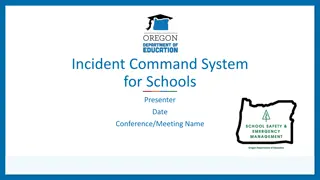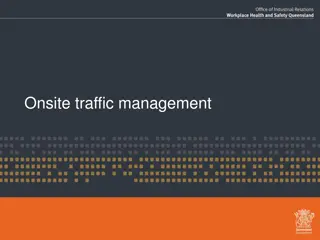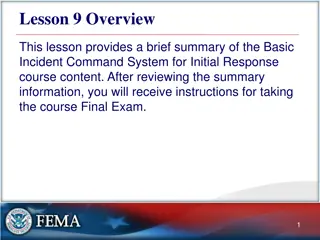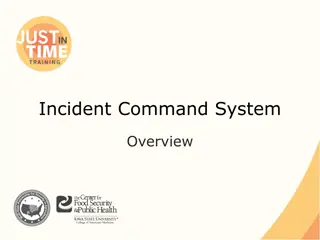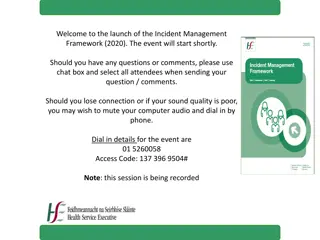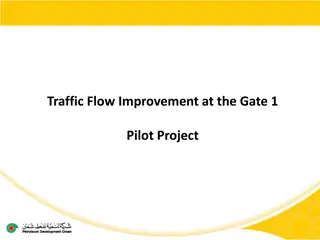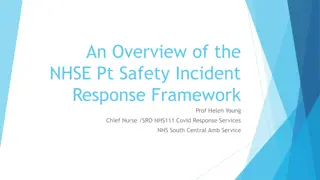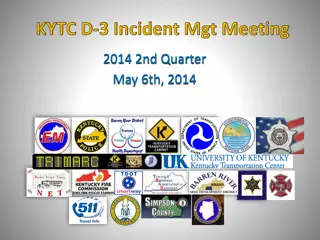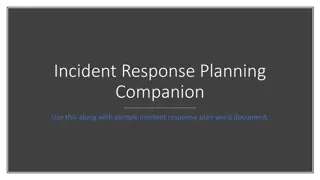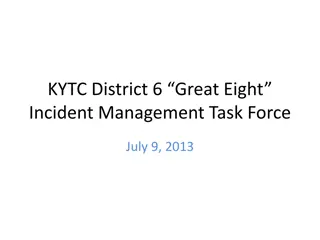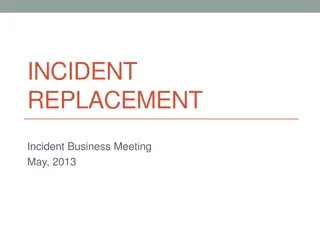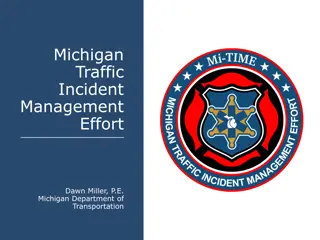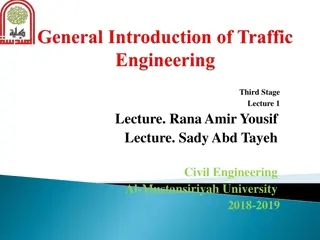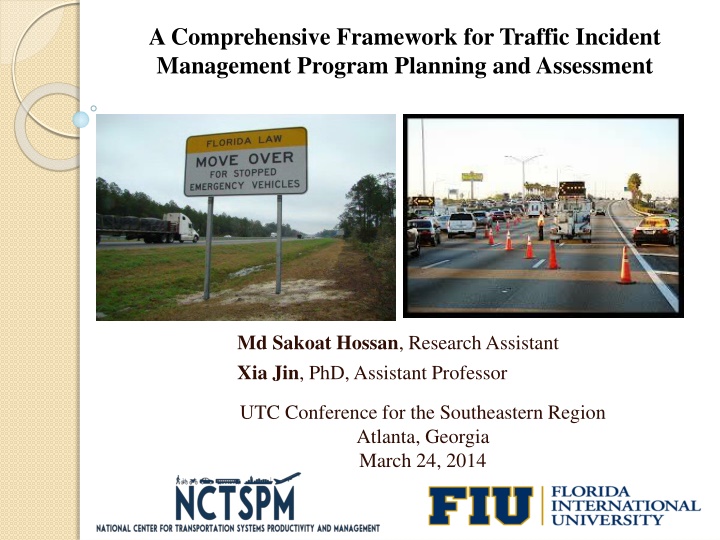
Comprehensive Framework for Traffic Incident Management Program
Develop a comprehensive framework for Traffic Incident Management program emphasizing key components, contributing elements, and applicability in program assessment. The proposed framework covers strategic and tactical support, formal program establishment, response management, resource allocation, evaluation, detection, traffic clearance, data management, communications, performance measures, dispatch, towing, safe clearance policy, communications strategies, hazardous material clearance, equipment verification, service patrols, incident response teams, sustainability, finance, documentation, traveler information, and more.
Download Presentation

Please find below an Image/Link to download the presentation.
The content on the website is provided AS IS for your information and personal use only. It may not be sold, licensed, or shared on other websites without obtaining consent from the author. If you encounter any issues during the download, it is possible that the publisher has removed the file from their server.
You are allowed to download the files provided on this website for personal or commercial use, subject to the condition that they are used lawfully. All files are the property of their respective owners.
The content on the website is provided AS IS for your information and personal use only. It may not be sold, licensed, or shared on other websites without obtaining consent from the author.
E N D
Presentation Transcript
A Comprehensive Framework for Traffic Incident Management Program Planning and Assessment Md Sakoat Hossan, Research Assistant Xia Jin, PhD, Assistant Professor UTC Conference for the Southeastern Region Atlanta, Georgia March 24, 2014 1
Scope of the Research Develop a comprehensive framework for Traffic Incident Management (TIM) program that Highlights the key components Outlines the contributing elements Serves as a basic guideline in program planning & assessment Framework has been presented at last year s UTC conference Focuses on the applicability of the framework in program assessment using a case study based on FDOT District IV TIM program 2
Proposed Traffic Incident Management Framework Traffic Incident Management Program Strategic Tactical Support Formal Program Establishment Response /Scene Management Resource Management Evaluation and Revision Detection / Verification Traffic Clearance and Recovery Data / Information Communicatio ns Management Performance Measures Dispatch & Towing Management Teams Safe, Quick Clearance Policy Strategic Communications Promotion Staff Detection Gathering Evaluation & Improvement Process Hazardous Material Clearance Plan Tactical Equipment Verification Service Patrols Diversion Plans Processing Development Communications Signage and Control Systems Major Incident Response Team Media Sustainability Finance Documentation On-Scene Tools Dissemination Communications Traveler Information Sharing 3
Characteristics of The Proposed Framework Consistent Consistent with the latest evolution Allows special techniques better suited for specific locals Applicability Hierarchy Follows the hierarchical structure Outlines all key components and elements with structured details Comprehensive Useful at every stage of TIM program, from program initiation to program restructuring Usefulness Intends to leverage an understandable framework Understandable 4
Strategic Preparation Joint Operation Policy (JOP) Determine what policies agencies have in place regarding fundamental Traffic Incident Management Serves as the primary document for the following TIM components Administrative Authorization Contracts & Agreements Strategic Missions & Goals Coordinated Activities 5
Strategic Preparation Incident Response Manual (IRM) Designed to provide uniform guidelines for incident responders Outlines the primary roles and responsibilities of the various agencies Serves as the primary document for the following TIM components Response Vehicle Parking Plan Flashing Lights Policy Safety Incident Command System 6
Strategic Preparation Memorandum of Understandings (MOU) Intended to provide the initial framework and guidelines to promote a collaborative effort Serves as the primary document for the following TIM components Organizational Structures MOUs Regular Meetings Inter-Agency Agreements 7
Strategic Preparation Open Roads Policy An MOU between Florida Highway Patrol (FHP) and Florida Department of Transportation (FDOT) All incidents need to be cleared from the roadway within 90 minutes of the arrival of the first responding officer Both agencies will evaluate and continually update and modify their operating policies, procedures, rules, and standard Each FDOT District will develop and implement response procedures 8
Strategic Component Potential Areas for Improvement Following improvement areas are identified through the proposed TIM framework Organizational Structure: Well-defined organizational structure Resource Identification: Automated resource identification policy Reimbursement Procedures: Separate finance section Improvement Procedures: Task Force and Feedback Committee 9
Tactical Preparation Road Ranger Provide free highway assistance services One of the most effective TIM program of FDOT Fully equipped to handle minor roadside emergencies Assisted 129,805 customers in 2012 10
Tactical Preparation Severe Incident Response Vehicle (SIRV) Provide an immediate response for severe incident lasting longer than two hours Acts like a FDOT correspondence, responds 24/7, dispatched by TMC Highly trained uniform incident management specialist Carries necessary incident management equipment 11
Tactical Preparation Rapid Incident Scene Clearance (RISC) An incentive based heavy duty wrecker clearance program Provides incentive for timely incident clearance Payment is reduced for each minute over the time limit A time suspension clause will exist for Hazardous materials or extended clean-up 12
Tactical Preparation Maintenance Of Traffic (MOT) A series of comprehensive online training video Each responder should receive appropriate training Followed Temporary Traffic Control (TTC) procedures described in MOT Designed to clearly define detour operations 13
Tactical Component Potential Areas for Improvement Agencies exhibit better performance in tactical component The following improvement area has been identified through the proposed TIM framework Secondary Incident Tracking: identifying criteria for secondary incidents Oregon DOT tracking criteria identification Virginia DOT dynamic queue-based identification tool 14
Support Preparation Inter-Agency Video Event Data Distribution System (IVEDDS) IVEDDS is a web-based application that allows partner agencies to access the roadway information IVEDDS distributes live motion, closed circuit television (CCTV) camera video feeds to partner agencies Received FHWA award for Innovative Ideas Helps the District to foster relationships with regional public agencies 15
Support Component Potential Areas for Improvement FDOT District IV have a robust ITS infrastructure, which eventually helps TIM program The following improvement area has been identified through the proposed TIM framework Data Integration & Processing Tools Integrating data from different sources Data Quality Data Storage Capacity Automated Data Processing 16
FHWA TIM Self Assessment National TIM Program Assessment (2011) Strategic 53.4 Tactical 75.3 Support 73.7 FDOT District Four TIM Program Assessment Year National Broward Palm Travel Cost 73.3 58.7 38 Beach 80.6 77.9 60.1 2012 2011 2010 68.2 63.9 60.0 89.6 84.2 81.4 17
Discussion The proposed framework Serves as an outline of all the key factors that are necessary for a successful TIM program Provides structured details and elements that help achieving the goals of each program component Could be useful at every stage of the TIM program from development of a new program to evaluating any existing program or restructuring the program 18
Questions & Answers Xia Jin, Ph.D., AICP Department of Civil and Environmental Engineering Florida International University 10555 W. Flagler Street, EC3603, Miami, Florida 33174 Tel: (305) 348-2825 Fax: (305) 348-2802 Email: xjin1@fiu.edu Md Sakoat Hossan Department of Civil and Environmental Engineering Florida International University 10555 W. Flagler Street, EC3725, Miami, Florida 33174 Tel: (786) 209-0375 Fax: (305) 348-2802 Email: mhoss009@fiu.edu Thank You 19


